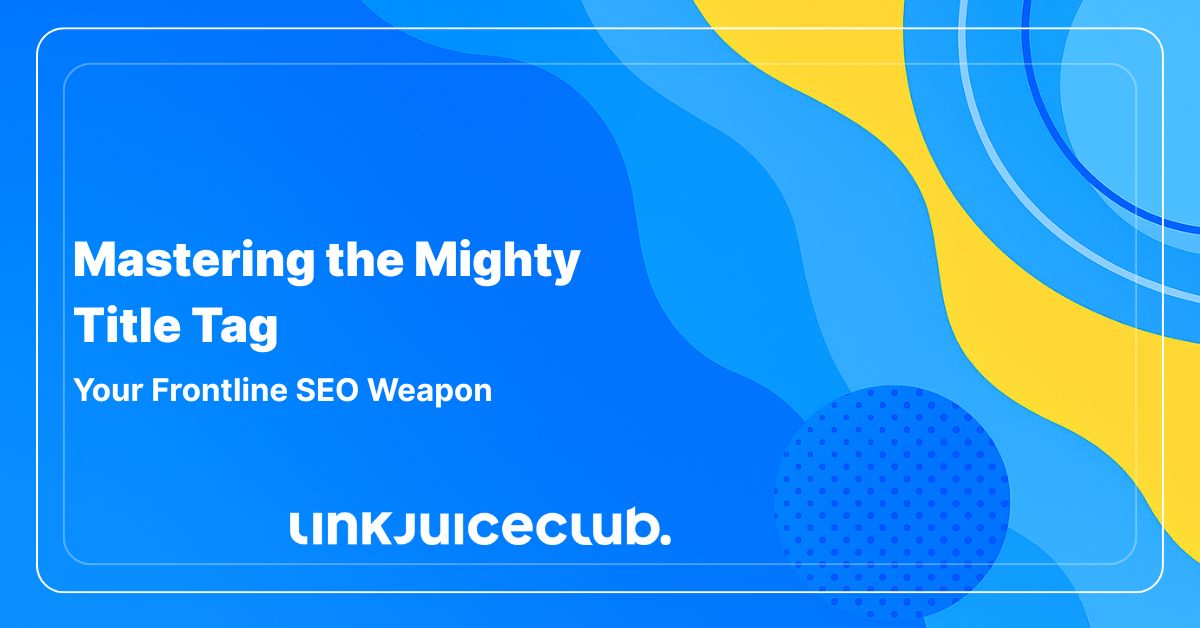
Mastering the Mighty Title Tag: Your Frontline SEO Weapon
If content is king, the title tag is the battle cry. It’s the first thing users see in search results, and the first signal search engines use to judge whether a page deserves a top spot. Title tags carry weight — a lot of it. When done right, they drive clicks, boost visibility, and set the stage for everything that follows.
This guide breaks down exactly what makes a title tag effective. From writing styles that grab attention to structural tweaks that improve rankings, it’s all here. Whether you’re optimizing for search, users, or both, learning how to craft better titles is one of the highest-impact skills in the game.

Let’s dive in.
So… What Exactly Is a Title Tag?
Think of a title tag as your page’s elevator pitch — squeezed into 60 characters or less. It’s the clickable blue headline you see on Google, and also what pops up on your browser tab. Here’s what it looks like behind the curtain:
<title>How to Write Title Tags for SEO That Rank – Link Juice Club</title>
Important note: title tags ≠ blog post titles. While your blog title sets the tone for readers on your site, title tags speak directly to search engines and potential visitors scrolling through the SERPs. That’s why it’s common to add your brand name at the end of a title tag — it builds trust and helps with recognition.
Bottom line? Title tags are not optional decoration. They’re one of the most important on-page ranking signals in SEO. Nail them, and you’re well on your way to better rankings, higher clicks, and more traffic that actually converts.
How to Write Title Tags That Don’t Just Rank — They Rake In Clicks
Before we geek out on the SEO mechanics, let’s zoom out and talk about the real MVP of any title tag: the human reading it. Because guess what? Even the most optimized title tag won’t move the needle if it doesn’t make people want to click.
Clicks = traffic. Traffic = dwell time. Dwell time = rankings. So yes, writing title tags that appeal to people (not just bots) is absolutely part of the SEO game.
🏷️ Brand Power (Use It If You’ve Got It)
If your brand has authority, trust, or even just name recognition, absolutely flex it in the title tag. It’s a trust signal — and trust converts.
But here’s the catch: if your brand is still building steam and the space is tight, skip it. Every character counts. Examples that get it right:
- Foam Mattresses from Casper
- Back Exercises in 15 Minutes a Day – Mayo Clinic
- 40 Best Christmas Party Theme Ideas 2025 – Oprah Daily
✅ Pro Tip: Stick your brand name at the end, especially if it’s well-known. If it’s not, focus on what does move the needle.
📅 Freshness Sells (So Keep It Current)
The internet has a short attention span. If your title tag says 2020, most users are scrolling right past. But add in the current year — or even the current month, if it makes sense — and boom, perceived freshness.
This works wonders in fast-moving spaces like:
- ✈️ Travel
- 💻 Tech gear
- 💰 Finance
- 📈 Anything trend-based
Go Big or Go Home? How Content Volume Impacts Clicks
Sometimes, size gets the click — especially when your title tag promises a mega list. Users love quantity when they’re in the mood to browse. Think home decor ideas, party themes, or wedding inspo. If it’s visual and listy, a big number works like magic.
Searches that show a lot of photos on the results page are your cue. That usually means users are looking for inspiration, not conclusions — so hit them with the big lists and let them scroll to their heart’s content.
- 📝 Examples that work like a charm:
- 🍂 85 Fall Wedding Ideas for the Ultimate Autumn Event
- 🛋️ 100 Living Room Design Ideas & Pictures
- ✨ 70+ Stunning Living Room Ideas
But be careful. There’s a flip side. If you’re writing about something where expert curation matters more than volume — like SEO tools, productivity apps, or best VPNs — skip the “99-item roundup.” In those cases, people want fewer, smarter recommendations.
The key is to match the number to the intent. If they’re browsing, go big. If they’re deciding, go smart.
1. Fast = Valuable: Why Speed Sells in Title Tags
People are impatient — and Google knows it. If your title tag hints that you’re about to save someone time, that’s an instant win. Whether it’s a shortcut, a cheat sheet, or a lightning-fast guide, users are far more likely to click when they feel like they’re getting immediate value.
This “velocity effect” shows up in content that promises speed, simplicity, or time-saving hacks. And it doesn’t always need to say “fast” — the structure of the title alone can scream efficiency.
- ⚡ Examples that tap into speed-hungry searchers:
- 📝 How To Write a Wedding Card [33 Examples]
- ✉️ 5 Cold Email Outreach Tips [Free Template]
- 👔 How To Tie a Tie in 30 Seconds
- 🩺 How To Become a Registered Nurse in 24 Months
- 😴 How To Fall Asleep Fast in 10, 60 or 120 Seconds
- 🍫 Easy Hot Chocolate Bombs (VIDEO)
If your content can help people skip steps, save time, or move faster — say so in the title tag. It’s one of the easiest ways to boost clicks and engagement.
Cheap Clicks, Big Impact: Using Price to Drive Traffic
Nothing grabs attention like a good deal. If your offer includes a low price, big discount, or even the word “free”, say it loud and proud in the title tag. People scanning the SERPs are wired to notice numbers — especially the small ones.
Whether you’re selling something, recommending deals, or curating discounts, price-focused title tags can make you stand out from the competition. Just be sure the content actually delivers, or you’ll lose trust faster than you gained the click.
- 💸 Examples that speak to bargain-hunters:
- 🎁 50 Senior Discounts For Up to $100 Off
- ✈️ $28 Cheap Flights to Austin, TX, in 2021
- 👕 1 Dollar T-Shirts for Men, Women, and Kids
- 📅 Free Printable Calendars For 2025–2026
Just remember — this works best when the price is central to the value. Don’t force a number in just to stand out. Make it real, make it relevant, and let your title tag do the heavy lifting.
2. Could This Title Tag Be Written by Anyone? If Yes, Rework It.
Here’s a spicy tip: if your title tag sounds like something any random SEO could’ve cranked out in five minutes, it’s not good enough.
The best-performing titles aren’t generic. They show subject-matter knowledge — or at least a clear grasp of the topic that only someone who “gets it” would write. This helps in two ways: users trust it more, and search engines may pick up on those industry-specific signals (especially through co-citations).
The goal? Write title tags that prove you know your stuff. Examples you can’t fake without knowing the field:
- 🎮 What Is Unity? The Game Engine Powering Thousands of Indie Titles
- 🔐 What Is MFA? Multi-Factor Authentication Explained for Modern Security
- 📉 Robinhood vs. E*TRADE: Which App Wins for New Investors?
If your title feels like it could be pasted onto any blog with any topic, scrap it. Start over and get specific.
3. [Brackets] in Title Tags = More Clicks (If You Use Them Right)
Want a quick hack for boosting CTR? Toss some brackets into your title tag — strategically.

According to some pretty solid studies, titles with brackets often outperform those without. Why? Because they signal extra value. Think [Free Template], [Guide], or [Data Study] — they look useful at a glance, and that makes people click.
- 🎯 Common click-driving bracket inserts:
- 📄 [Free Template]
- 🖨️ [Free Printable]
- 📊 [Data Study]
- 🧮 [Calculator]
Now, here’s the twist: Google sometimes rewrites titles with brackets more than others (especially longer ones). But that might just be because longer titles tend to include brackets.
Bottom line? If your title tag is short, sweet, and bracketed with purpose — go for it. Want to be extra safe? Try parentheses instead. Either way, test it, don’t guess it.
4. Odd Numbers = Oddly Effective
Let’s get weird for a second. Did you know titles with odd numbers tend to outperform even-numbered ones by around 20%? No one’s exactly sure why (and no, sadly, the study didn’t round it up to 21%), but we’re not here to argue with results.
Maybe it’s because odd numbers feel less polished and packaged, which makes them stand out in a sea of cookie-cutter content. They spark curiosity. They feel human. They don’t scream “templated.”
Of course, there are exceptions. If you’re doing a formal list — like “100 best destinations of 2025” — maybe don’t break that flow with “99.5 cool places.” But in most other cases? Odd wins.
- 🎯 Examples that pop:
- 💒 27 Ridiculously Fun Wedding Ideas – Here Comes The Guide
- 🛋️ 31 Living Room Ideas from the Homes of Top Designers
So the next time you’re picking a number for a listicle? Go odd. Go bold. Go clicky.
5. Technical Touch-Ups That Actually Move the Needle
Alright, we’ve talked about click psychology. Now let’s tighten up the technical title tag stuff — the nitty-gritty details that can subtly (but powerfully) affect performance. These aren’t flashy, but they’re the kind of tweaks that stack up over time.
🧩 Here’s what we recommend:
- 📍 Keep important words near the front: You don’t need to frontload every time, but don’t bury your lead either. Show users (and search engines) what the page is about — fast.
- 🧠 Match your post title to your title tag: Consistency builds trust. If users click on something in search and land on a page with the exact same title, it just feels right.
- 🔍 Watch the SERPs, not just keywords: If everyone else is using a slightly different phrasing in their titles, that’s not a coincidence. Google’s showing you the real topic intent. Pay attention and adapt accordingly.
- ➖ Use hyphens instead of pipes: A recent study showed hyphens tend to outperform pipes in rankings. It’s a subtle tweak, but it helps readability and clarity.
Good: 20 Unique Wedding Centerpiece Ideas – The Knot
Not-so-good: 20 Unique Wedding Centerpiece Ideas | The Knot
- 🏷️ Stick to the brand name only: Extra descriptors (like “expert advice” or “award-winning”) can dilute your message. Shorter titles are sharper — and sharper often means stronger.
- ⏳ Keep titles under 60 characters: Shorter titles are more likely to display properly in search results. Plus, long ones often get rewritten by Google, which defeats the point of writing them in the first place.
- 🔧 Want to test your title length? There are plenty of preview tools out there, but your best bet is to check the live SERPs for accuracy. What Google shows is what counts.
6. Track Your Titles Like You Mean It
Reading advice is easy. Remembering to use it? Not so much. That’s why it’s not enough to just write great titles — you need to build a system that keeps them front and center.
One of the simplest ways to do this? Add your title tags right next to your rank tracking data. It’s a small shift with a big impact. When you see your keywords, URLs, and titles side-by-side, you’re more likely to spot mismatches, missed opportunities, or outdated phrasing.
- 📋 Why this helps:
- 🧠 It reinforces what kind of titles drive performance
- 🔄 It helps catch outdated stuff (like last year’s date still showing)
- 🕵️ It highlights gaps where your title doesn’t match the page intent
Even if your CMS doesn’t auto-update dates or handle versioning cleanly, this simple tracking habit gives you eyes on the situation. Visibility = control.
Bonus: You’ll start to see patterns. And once you see the patterns, you start to win more consistently.
7. A/B Testing: Your Not-So-Secret Weapon for Title Wins
Let’s be honest: no matter how good your instincts are, you can’t know what works until you test it. That’s where A/B testing comes in — not in the lab coat, spreadsheet-overload way, but in a practical, let’s-actually-learn-something kind of way.
True split testing isn’t possible with organic traffic, but you can track performance over time using Google Search Console. It’s not perfect science, but it’s good enough to make confident, data-driven decisions.
- 🧪 What you should track:
- 📈 Clicks
- 🚦 Average Position
- 🎯 CTR (Clickthrough Rate)
- 👁️ Impressions
The best practice? Wait at least two weeks (more is better), and only test on pages that get enough impressions — think 2,000+ per period to have reliable insights.
📊 Here’s how to set it up:
- Push your new title live
- Watch the SERPs — once you see the change appear, start your test window
- After two weeks, pull the data
- Compare to the previous period using clean, aligned date ranges
- Look for deltas — did CTR spike? Did impressions increase? Did rankings shift?
And don’t forget a “control.” Compare your test page against a similar one that hasn’t changed. If your test page outperforms the control, you’re not just guessing — you’re learning.
🚨 Remember: It’s not about rankings alone. If your position dips but CTR climbs and traffic goes up? That’s a win. Always optimize for results, not ego metrics.
Testing at Scale Without Needing Big Traffic
Not every page pulls in enough traffic to justify a full-blown test, but that doesn’t mean you can’t still run meaningful experiments. If you’re working with a group of similar pages—think profile pages, location pages, or templates that follow the same structure—you can test them as a group. When bundled together by theme, even smaller pages can collectively reveal the impact of a title change.
This is where your analytics tool becomes your best friend. You can create an advanced search to filter only the URLs you’re testing, isolate organic traffic, and compare performance before and after your changes. Using the pipe symbol between URLs lets you group them easily, and from there, it’s just a matter of analyzing the difference. If you see a big bump, you’re onto something. If traffic dips, it’s worth reevaluating. If nothing changes, you didn’t lose anything—but you learned what doesn’t move the needle.
This style of testing works especially well when you’re stepping away from outdated tactics. We’ve seen title tweaks boost traffic by over 50% in certain niches, simply because the originals were stale or templated. These aren’t the tests you run when you’re chasing a fractional uptick. They’re the ones you use when you want a real shake-up—something noticeable. If you’re new to this kind of testing, the first few runs are usually where the biggest wins are hiding.
Turning Titles Into a Core Habit
Writing strong, attention-worthy titles isn’t just a task on a checklist—it’s a mindset. Some teams treat it like a box to tick off. Others treat it like a strategic advantage. Guess who gets better results?
The businesses that win don’t just write titles—they work them, revisit them, rethink them, and continually sharpen them over time. They don’t settle for generic, copy-paste headers. They look at what people are searching for, what’s showing up in results, and what real humans would actually click. That approach creates titles that do more than just fill space—they perform.
Titles are one of the most powerful levers you have to pull when it comes to visibility and engagement. Ignore them, and your content might never get the attention it deserves. Prioritize them, and you unlock growth without changing anything else on the page. When title strategy becomes second nature—baked into every campaign, audit, and piece of content—you stop treating traffic as luck and start treating it as something you control.
If you’re serious about doing this right, it’s not about tricks or templates. It’s about making smart, intentional choices every time you hit publish. That’s the difference between brands that show up and brands that win.





